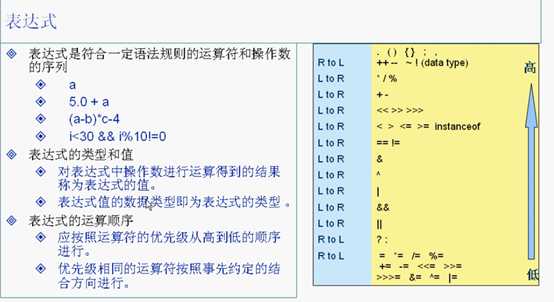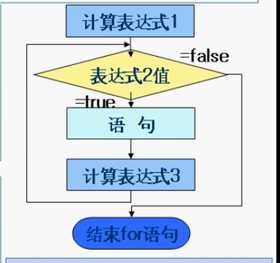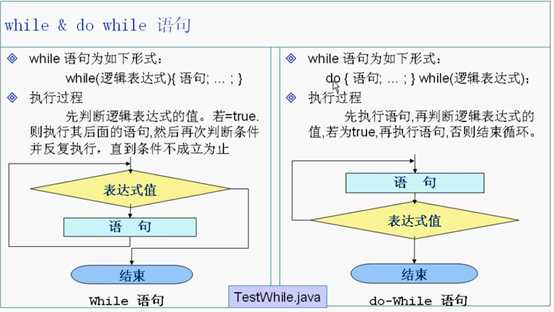J2SE之基础语法-算数计算符
Posted qnn108
tags:
篇首语:本文由小常识网(cha138.com)小编为大家整理,主要介绍了J2SE之基础语法-算数计算符相关的知识,希望对你有一定的参考价值。
Java语言支持如下运算符:
算数运算符:+,-,*,/,%,++,--
关系运算符:>,<,>=,<=,= =,!=
逻辑运算符:!,&,|,……,&&,||
位运算符:&,|,^,~,>>,<<,>>
赋值运算符: =
扩展运算符:+=,- =,*=,/=
字符串连运算符:+
//^:异或
自加和自减运算符:
public class Test{ public static void main(String[] args){ int i1 = 10, i2 = 20; int i = (i2++); System.out.print("i=" + i); System.out.println("i2=" + i2); i = (++i2); System.out.print("i=" + i); System.out.print(" i2=" + i2); i = (--i1); System.out.print("i=" + i); System.out.println(" i1=" + i1); i = (i1--); System.out.print("i=" + i); System.out.println(" i1=" + i1); } }
逻辑运算符

短路与/短路或:只要第一个操作数确定了,第二个操作数不再计算
赋值运算符与扩展赋值运算符
赋值运算符(=)
当“=”两侧数据类型不一致时,可以适用默认类型转换或强制类型转换原则进行处理
long 1 = 100; int i = (int)1;
注意:可以将整型常量直接赋值给byte,short,char类型变量,而不需要进行强制类型转换,只要不超出其表数范围
byte b = 12; char c = 100;
x byte bb = 256; X short s = -32769;

字符串连接符
“+”除用于算数加法运算外,还可以用于对字符串进行连接操作
int id = 800 + 90;
String s = "hello" + "world";
“+”运算符两侧的操作数中只要有一个是字符串(String)类型,系统自动将另一个操作数抓换为字符串然后再进行连接
int c = 12;
System.out.println("c=" +c);

三目条件运算符
“三目条件运算符,语法格式”:
x?y:z
其中x为boolean类型表达式,先计算x的值,若为true,则整个三目运算的结果为表达式y的值,否则整个运算结果为表达式z的值
例子:
int score = 80; int x = -100; String type = score < 60 ? "不及格" : "及格" int flag = x > 0 ? 1 : (x == 0 ? 0 : -1); System.out.println("type=" + type); System.ouit.println("flag=" + flag);

语句
条件语句-根据不同条件,执行不同语句。
- if
- if..else
- if..else if
- if..else if..else if ..else
- switch
循环语句-重复执行某些动作
- for
- while
- do..while;
if语句
- if
- if..else
- if..else if
- if..else if..else if
- if..else if..else if..else
- 只有一句需要执行的语句时,可以省略{}
public class TestIF{ public static void main(String[] args){ int = 20; if(i <20){ System.out.println("<20"); System.out.println("<20"); }else if (i < 40 ){ System.out.println("<40"; }else if(i < 60){ System.out.println("<60"); }else ( System.out.println(">=60"); System.out.println(">=60"); } }
else 要带{}
for循环语句
- for语句如下形式:
for(表达式1;表达式2;表达式3){语句;....;}
- 执行过程
首先就算表达式1,接着执行表达式2,若表达式2的值=ture,则执行语句,接着计算表达式3,再判断表达式2的值;依次重复下去,指导表达式2的值=flase
for语句中三个表达式可以省略

例子:计算result = 1!+2!+...+10!
public class Test{ public static void main(String[] args){ long result = 0; long f = 1; for(int i = 1;i <= 10; i++){ f = f * i; result += f; } System.out.println("reslut=" + result); } }
编写程序,用一个for循环计算1+3+5+7+......+99的值,并输出计算结果。(OddSum.java)
public class OddSum{ public static void main(String[] args){ long reslut = 0; for(int i = 1;i < 100;i=+2){ result += i; } System.out.println("reslut=" + result); } }
while & do while 语句

public class TestWhile{ public static void main(String[] args){ int i = 0; while(i < 10){ System.out.println(i); i++; } i = 0; do{ System.out.println(i); i++; }while(i < 10); } }
条件都是用()括起来,语句都是用{}括起来。
break&Continue语句
break语句用于终止某个语句块的执行,用在循环语句中,可以强行退出循环:
例如:
public class Test{ public static void main(String agrs[]){ int stop = 4; for(int i = 1; i <= 10; i++){ //当i等于stop,退出循环 if( i == stop)break; System.out.println("i = " +i); } } }

continue语句用在循环语句中,用于终止某次循环过程,跳过循环体中continue语句下面未执行的循环,开始下一次循环过程:
例如:
public class Test{ public static void main(String[] args){ int skip = 4; for(int i = 1; i <= 5; i++){ //当i等于skip时,跳出档次循环 if(i == skip)continue; System.out.println("i = " +i); } } }

continue:终止此次循环,开始下一次循环。
循环语句举例
//输出1~100内前5个可以被3整除的数。
public class Test{ public static void main(String[] args){ int num = 0, i = 1; while(i<=100){ if (i % 3 ==0){ System.out.print(i +" "); num++; } if(num == 5){ break; } i++; } } }
//输出101~200内的质数:
public class Test{ public static void main(String[] args){ for(int i = 101; i<200; i+=2){ boolean f = true; for(int j = 2; j<i; j++){ if(i % j == 0){ f = false; break; } } if(!f){continue;} System.out.print(" " + i); } } }
switch语句(条件语句补充)
switch(){
case xx:
....
case xx:
....
default:
....
}
小心case穿透,推荐使用break语句
多个case可以合并到一起
default可以省略,但不推荐省略
switch
java中switch语句只能探测int类型值
public class TestSwitch{ public static void main(Sting[] args){ int i = 18l switch(i){ case 8; //System.out.println("2"); //break; cast 3: //System.out.println("3"); //break; case 2 : System.out.println("8"); case 9: System.out.println("9"); break; default: System.out.println("error"); } } }
方法
Java的方法类似于其它语言的函数,是一段用来完成特定功能的代码片段,声明格式:
[修饰符1 修饰符2 .】返回值类型 方法名(形式参数列表){
Java语句:... ... ...
}
形式参数:在方法被条用时用于接收外界输入的数据。
实参:调用方法时实际传给方法的数据。
返回值:方法在执行完毕后返还给调用它的环境的数据。
返回值类型:事先约定的返回值的数据类型,如无返回值,必须给出返回值类型void。
Java语言中使用下述形式调用方法:对象名,方法名(实参列表)
实参的数目、数据类型和次序必须的所调用方法声明的形参列表匹配,
return语句终止方法的运行并指定返回的数据。
Java中进行函数调用中传递参数时,遵循传递的原则:
基本类型传递的是该数据值本身。引用类型传递的是对对象的引用,而不是对象本身。
例子:
public class TestMethod{ public static void main(String[] args){ m(); m2(2); m3(‘3‘,4); m4(4, 6); int i = m4(4, 6); System.out.println(i); } public static void m(){ //return; System.out.println("ok"); System.out.println("hello"); } public static void m2(int i){ if(i > 3) return; System.out.println(i); } public static void m3(int i ,int j){ System.out.println(i + j); } public static int m4(int i , int j){ return i > j ? i : j; } }
以上是关于J2SE之基础语法-算数计算符的主要内容,如果未能解决你的问题,请参考以下文章